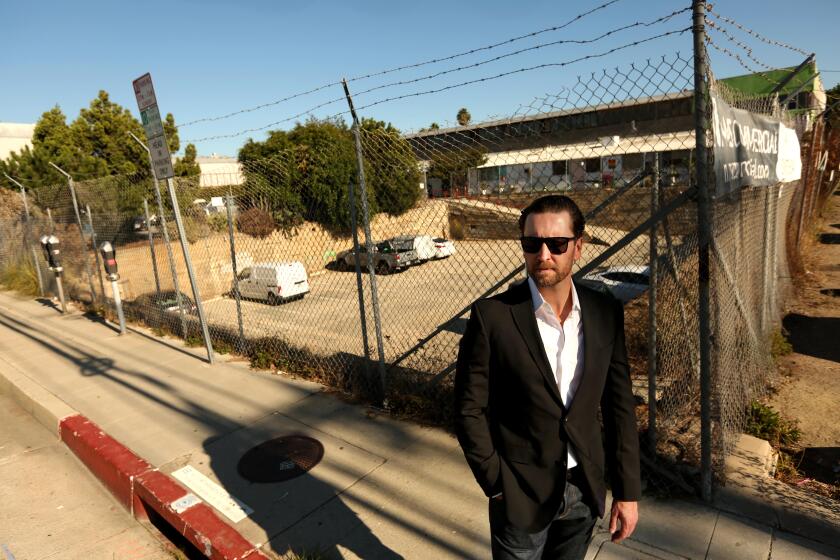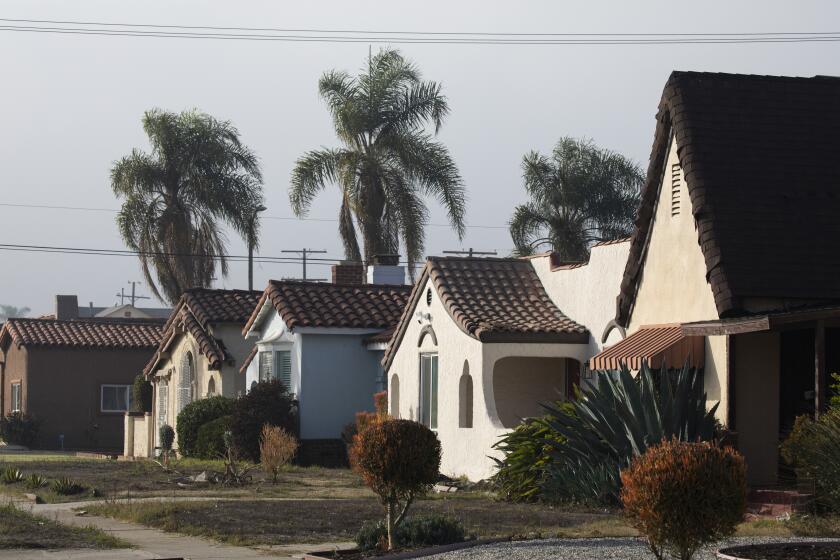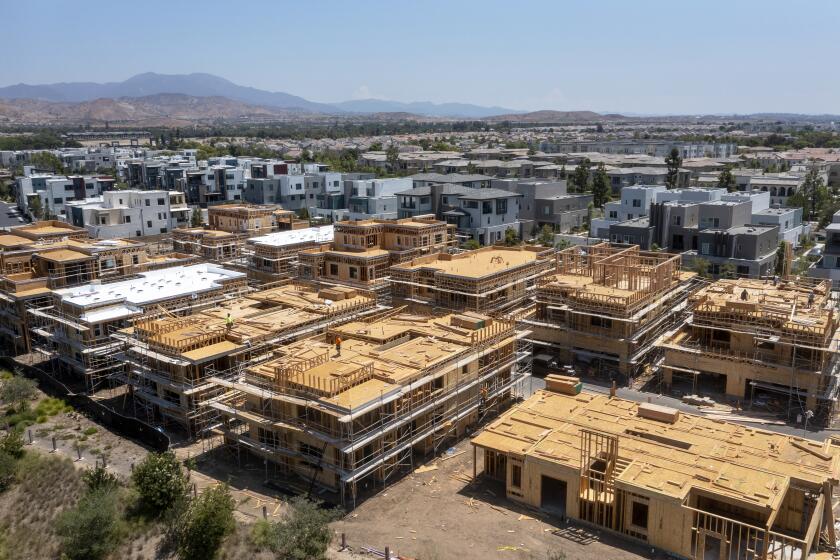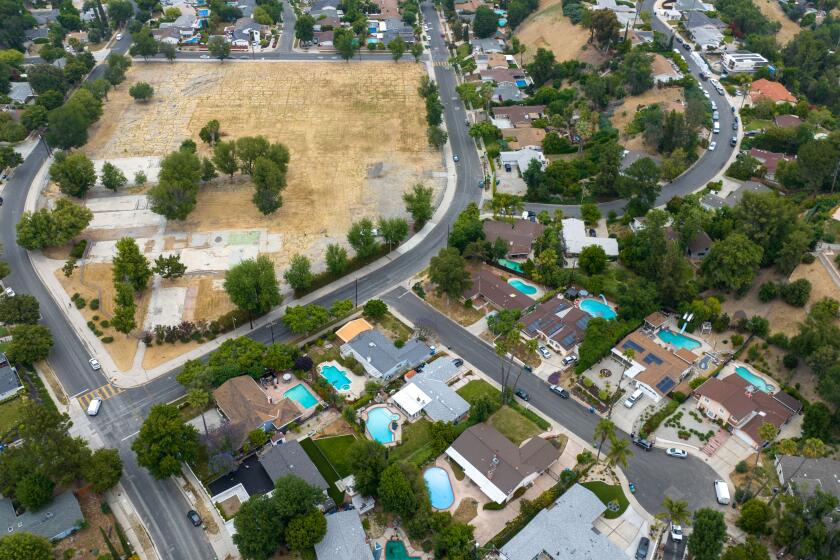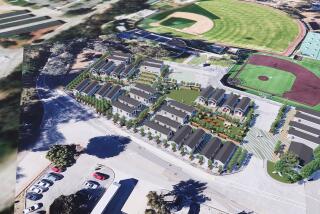This L.A. developer aims to tear down homes to build apartments where the city doesn’t want them
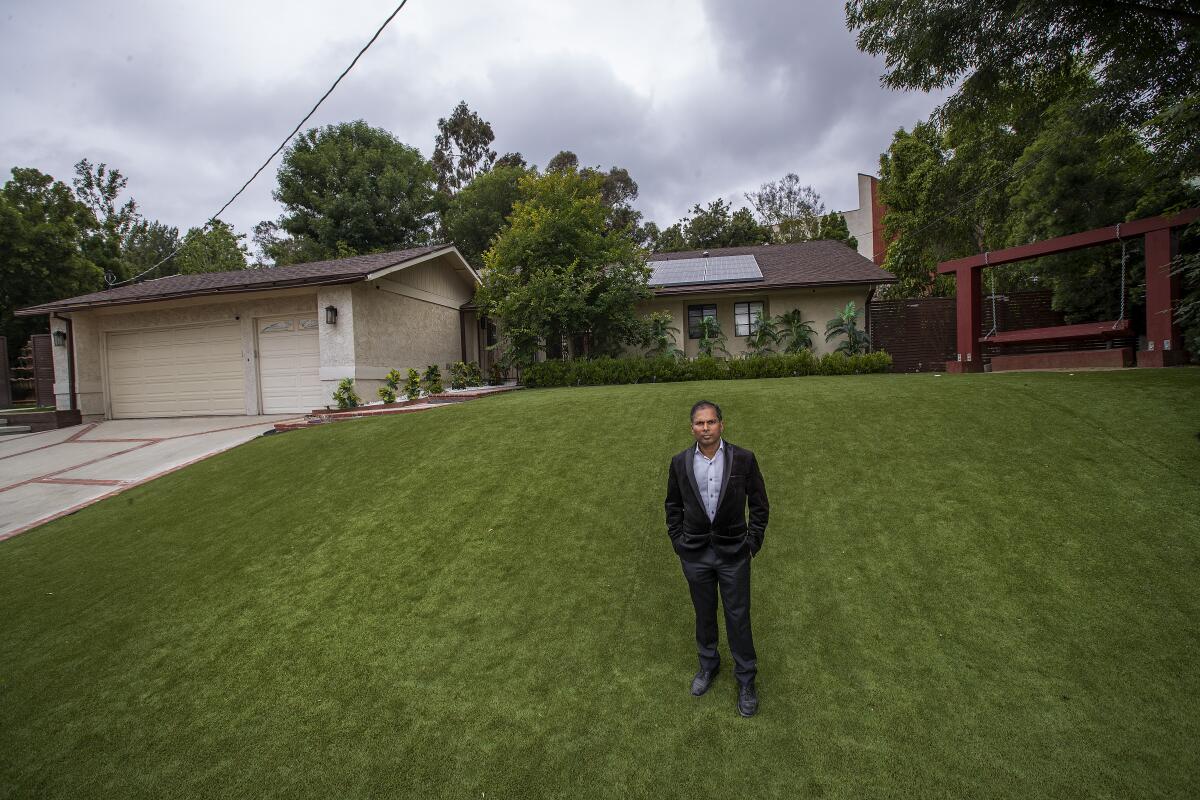
- Share via
Up in arms over developer Akhilesh Jha’s proposal to replace a single-family home with a seven-story apartment complex, neighbors in the Harvard Heights community turned to the city for help.
The Los Angeles Planning Commission obliged, ordering Jha to scale down the project.
But Jha, a 49-year-old aerospace engineer turned real estate developer, refused. Instead, when he returned to the planning commission months later, Jha had added an eighth floor.
“He came back with something that was even worse,” said Brian Jett, who lives three doors down from the proposed development. “It’s mind-boggling.”
Jha believed he had the law on his side, and after an hour-and-a-half hearing in February, the planning commission agreed. His 33-unit apartment complex was approved unanimously, and Jha hopes to break ground within a year.
“I’m offended by it,” said Samantha Millman, the planning commission chair. “But I have no choice but to vote for it.”
Developers in Santa Monica are planning 4,500 new apartments under a little-known state legal provision — and the city might not be able to stop them.
Jha is banking his business on moments like these. Jha has spent the last six years paging through state laws and city zoning codes. His homework leads him to snap up single-family homes where he decides the law will let him build much bigger, no matter what anyone else thinks.
Jha is taking advantage of an opportune moment when California politics are turning away from the slow-growth mantra that has dominated in established cities and suburbs over the last half century. In the face of a crushing housing affordability crisis and shortage of available homes, state lawmakers have approved more than 100 new laws in six years that are designed to incentivize new housing proposals and force local governments to approve them.
In Los Angeles, no one is pushing the envelope more than Jha. Besides the 33-unit Harvard Heights project nestled between the 10 Freeway and Koreatown, he has two proposals in the San Fernando Valley to tear down single-family homes and build dozens of apartments and townhomes on the sites — all efforts that never before would have stood a chance of getting built.
Jha’s plans are kicking up scorn and anger. Millman, the planning commissioner, called the Harvard Heights building a “middle finger to the community,” a reference both to the developer’s attitude toward his neighbors and the visual of an 89-foot-tall structure lording over the one-, two- and three-story buildings nearby. Neighborhood leaders in the Valley worry that Jha’s projects will bring in criminals or ruin the rustic suburban character sustained over decades.

Subscribers get exclusive access to this story
We’re offering L.A. Times subscribers special access to our best journalism. Thank you for your support.
Explore more Subscriber Exclusive content.
While Jha’s ideas are far out of scale with nearby properties, he’s also not plopping the buildings in the middle of subdivisions. The projects are all within about half a mile of a major freeway with other multifamily housing and businesses nearby.
Jha has already won one court case vindicating his interpretation of city zoning rules and is prepared to go back for more.
“There will always be conflict,” Jha said. “But the law is very clear: Resolve that conflict in the best interest of producing the housing.”
After immigrating to the United States in the late 1990s, Jha spent two decades designing rockets and planes while working for aerospace firms. He married, had a son and, as he entered middle age, decided he wanted something new and turned to real estate.
A California law passed in 2021 was supposed to make it easier for homeowners to build duplexes, but few are taking advantage of it.
At first, Jha wanted to buy a small apartment complex. But when he was outbid for a property in San Pedro he thought a better way to make money was to find a house he could tear down and replace with apartments.
He had absolutely no construction background.
“Never ever built a tent in my life,” he said.
A native Hindi speaker, Jha armed himself with an English dictionary to help with words he didn’t understand while scouring property listings, laws and zoning codes for places to build. He found the crumbling two-story Victorian in Harvard Heights in the West Adams district for $840,000.
Sign up for This Evening's Big Stories
Catch up on the day with the 7 biggest L.A. Times stories in your inbox every weekday evening.
You may occasionally receive promotional content from the Los Angeles Times.
The contentious experience galvanized him. He spent a year fighting an effort to make the home a historic landmark, which would have blocked its redevelopment. After winning, he planned to build a 20-unit apartment complex under a city program that provides incentives for developers near mass transit.
But after months of work, he learned that rules requiring him to have a specifically sized driveway and room for an electrical transformer didn’t leave enough area on the lot to provide sufficiently wide ground-floor commercial space. Jha abandoned his application, but not before he had lost tens of thousands of dollars in permitting fees and design costs, he said.
His plans in a shambles, Jha returned to his research and found a state law known as the “density bonus.”
Many of the states that have provided refuges for Californians fleeing high housing prices added much more housing in the last two years than the Golden State did.
In the simplest terms, the law allows developers to build more dense housing on a lot in exchange for dedicating some of the units for low-income families. Jha will set aside three of his 33 apartments for that purpose.
By doing so, Jha gets to bypass all sorts of city zoning and planning rules. The height of the building will be double what’s otherwise allowed, its width will cover nearly the entire lot and Jha only has to provide 20 parking spaces on the site. Most important for him, the law says that as long as Jha testifies these waivers are necessary, the city’s hands are tied.
“The city made me go through hearing after hearing after hearing,” Jha said. “Then they would sometimes put a hold on my project because they wanted me to reduce the height, they wanted me to reduce the density. But I stuck to my project and I stuck to the law.”
Strengthening the density bonus for developers was one of the key changes approved by state legislators in recent years to increase both affordable and overall housing production, said Ben Metcalf, managing director of UC Berkeley’s Terner Center for Housing Innovation and former director of the state Department of Housing and Community Development.
“You can basically choose anything you don’t like in the zoning rules and you get free passes to throw it out the window,” Metcalf said. “It’s kind of an amazing law.”
Like Jha, builders across the state have sought to redesign projects by adding low-income and veterans housing, while reducing parking and yard space so they can get their projects approved even if there’s community outcry, Metcalf said.
“The neighbors have no real leverage anymore,” he said.
After an hour of debate, Herb Perez had had enough.
Jha’s proposals have left community members apoplectic. In Woodland Hills, Jha wants to replace a four-bedroom home with an apartment complex of 67 units, seven of which, because of the density bonus and related incentive programs, would be reserved for low-income disabled veterans.
Mihran Kalaydjian, vice president of the Woodland Hills/Warner Center Neighborhood Council, said the development would hurt the area.
“When you’re taking single-family homes and replacing them with big apartment buildings, the residents and the tenants of those apartments are coming from different backgrounds,” Kalaydjian said. “The different backgrounds could be criminal backgrounds. It could influence our neighborhoods.”
Kalaydjian, a landlord himself with seven properties around Woodland Hills, said the community has planned areas for commercial buildings and apartments. Departing from that blueprint, he said, could reduce property values and contribute to a general sense of disorder.
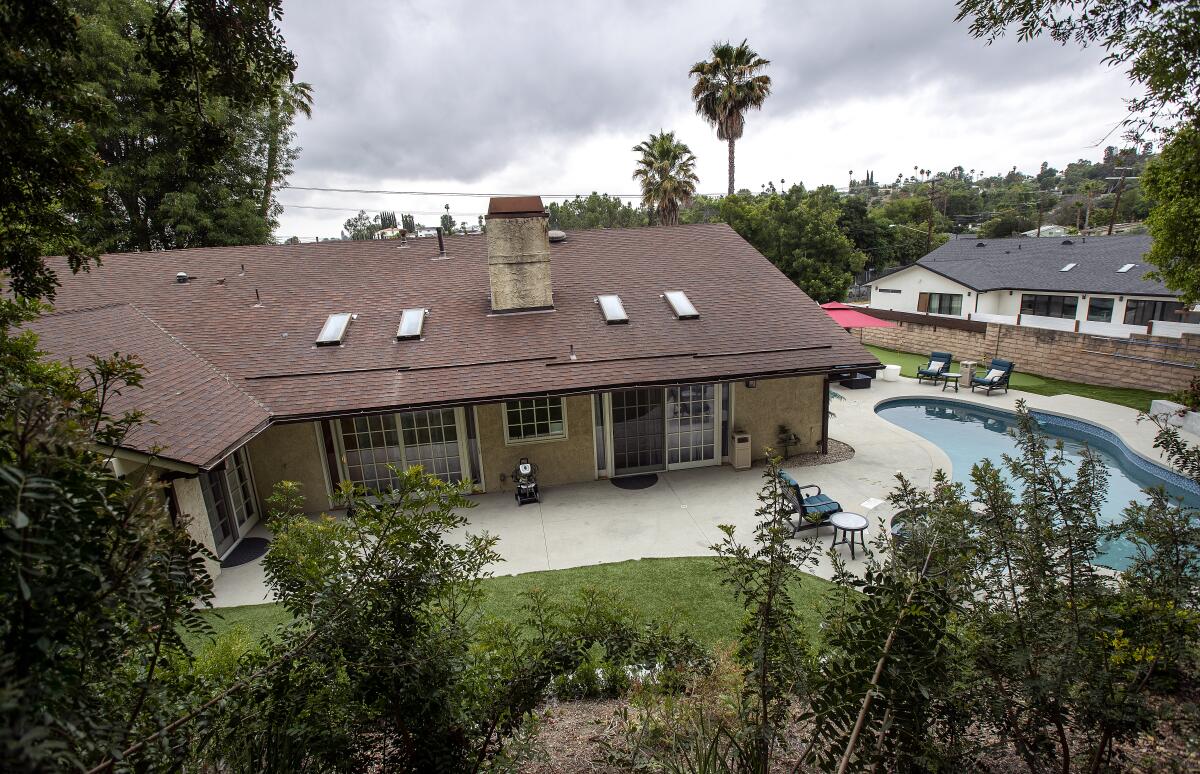
In Sylmar, Los Angeles’ northernmost neighborhood at the foot of the San Gabriel Mountains, community leaders believe Jha’s plan to build 40 townhomes on a one-acre site with a single-family home will destroy the area’s bucolic atmosphere.
The lot’s zoning requires that there’s enough space for horse stables, and townhomes would prevent horse-owning residents from ever living there, said Peter Postlmayr, a member of the neighborhood council.
Jha “bought a piece of property and it’s zoned for horsekeeping,” said Postlmayr, adding that there’s an extensive trail network the zoning designation aims to protect. “He’s trying to change that, which is to the detriment of those living near there.”
After years of dawdling by L.A. on the use of public land for homeless housing, an urban planner hired by the Committee for Greater L.A. has vetted thousands of government-owned parcels and come up with a list of 121 that it says are ready for development.
Jett and other neighbors in Harvard Heights insist that their opposition isn’t because they’re against housing, rather the specifics of Jha’s project. A 64-unit, four-story apartment complex for low-income senior citizens opened two years ago across the street with community support, they said.
Jha’s design includes a two-story above-ground parking garage that’s so wide exhaust vents sit less than ten feet from the small apartments next door. All the negative effects of the development plus the relatively few low-income units don’t justify its construction, Jett said.
“We’re totally cognizant of the housing crisis and all for affordable housing,” said Jett, an independent film director. “But this isn’t that.”
Metcalf, of UC Berkeley’s Terner Center, said state lawmakers understood nearby residents might dislike newer, larger projects when they were debating the bills. But they wanted to ensure that neighbors’ objections would be less likely to trump housing, especially in areas more primed for growth.
Coronado officials have thumbed their noses at Gov. Gavin Newsom and state regulators, calling the process “central planning at its worst” and assuring residents that it will be years before the state cracks down.
Besides the senior housing, multiple other apartment complexes line the block where Jha is proposing to build in Harvard Heights. Abutting the Woodland Hills development is a three-story commercial structure, and there’s a similarly sized apartment building two lots down. The Sylmar project sits on a busy street — albeit one with an equestrian crossing road sign — less than two blocks from the 210 Freeway.
“In concept, this is what we’re wanting to see happen on these three sites,” Metcalf said. “Some of the specifics may be pretty painful to those who live next door.”
Jha’s Sylmar proposal relies on the most aggressive interpretation of state regulations. Originally, he said, he was considering using a new law that allows single-family home owners to split their lots and build small developments on both. But then he came across a little-known provision in a different set of laws that only apply when the state has not signed off on cities’ required growth plans.
This provision, known as the “builder’s remedy,” allows developers to essentially propose constructing whatever they want — provided, again, that they set aside some of the future housing for low-income residents. In this case, it wouldn’t matter that the city’s zoning otherwise requires space for horse stables.
The city of Los Angeles was out of compliance with the state planning law only briefly. Jha slipped in his application last June during the two weeks between the City Council’s final adoption of the blueprint and the state accepting it. No one else has proposed a builder’s remedy project in the city, planning officials said, and, because the state now has approved L.A.’s plan, they’re no longer allowed.
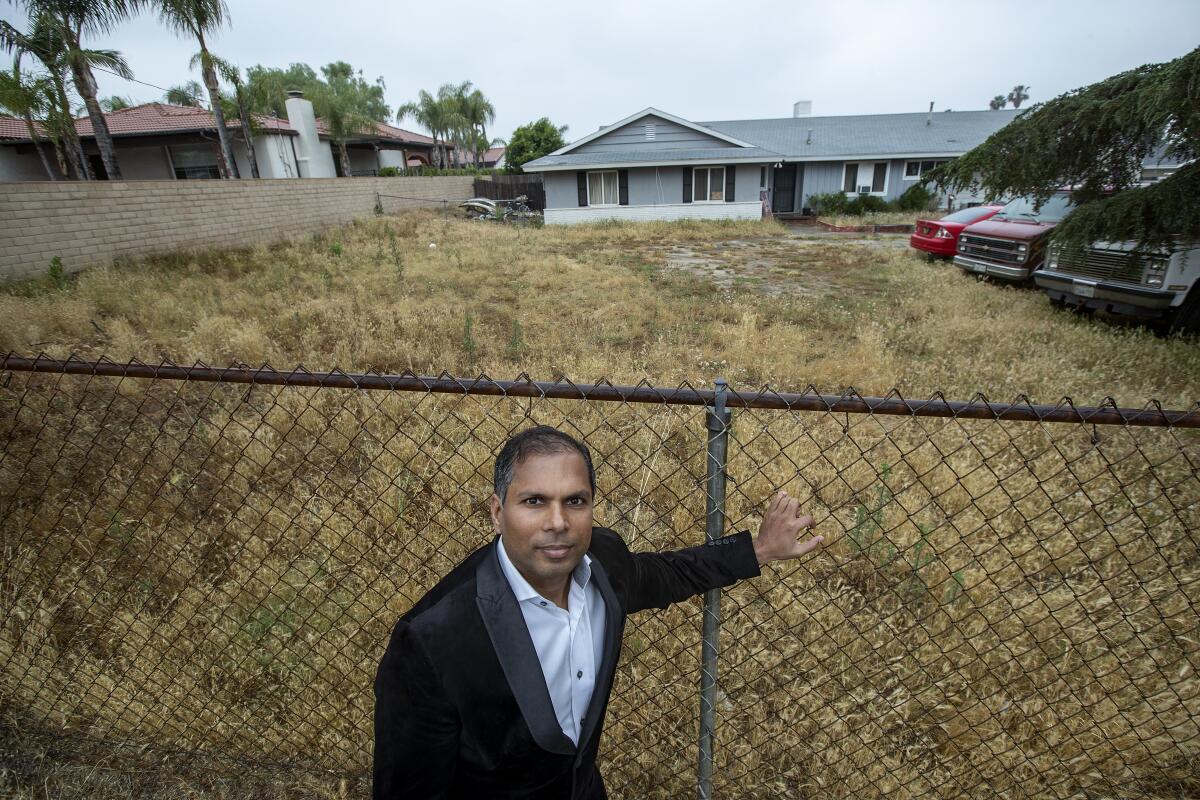
Jha has had some help in his fights. A few years ago, he contacted Sonja Trauss, one of the progenitors of the YIMBY, or Yes In My Backyard, movement, who runs a legal advocacy organization that sues cities for rejecting housing projects. She agreed to fund a lawsuit against Los Angeles in Jha’s effort to build in Woodland Hills.
Jha won the case last October, with an L.A. County Superior Court judge ordering the city to process his application. Ever since that first connection, YIMBY groups have mobilized behind his projects.
While Jha has finished smaller developments around the city, the three large efforts have yet to receive their final approval. In the meantime, he rents out his single-family homes to pay the mortgages.
The ‘wealth defense industry’ — a network of accountants and consultants tasked with helping the rich stay rich — is responsible for homeowners avoiding L.A.’s ‘mansion tax.’
He advertises the Woodland Hills house, which has a pool, hot tub and four holes of mini-golf on the property, for $350 a night on Airbnb.
In Harvard Heights, the Victorian has been used for decades as a sober living home. Eleven people live on the property now, said Earl Lee, the 76-year-old manager who has been there since the mid-1990s.
State and city laws require Jha to offer relocation benefits and housing in his new building to the existing tenants. He said he has no intention of displacing anyone who doesn’t want to go.
But city officials have questioned Jha’s compliance with those laws and have told him to better inform the tenants of their rights.
Lee said eight residents, including him, have expressed interest in coming back to the new development. But the paperwork to prove income and other eligibility requirements to return is burdensome, he said, and some who had wanted to stay already left the home.
After years of dawdling by L.A. on the use of public land for homeless housing, an urban planner hired by the Committee for Greater L.A. has vetted thousands of government-owned parcels and come up with a list of 121 that it says are ready for development.
“You can fight it if you want but most people just look for a different place,” Lee said.
Jha is pressing ahead with all his plans even as roadblocks continue. Last month, the City Council voted to deny his Sylmar project.
Jha went to City Hall to speak at the meeting, reminding city leaders that they’d lost to him in court before.
“You will lose the case again,” Jha said. “I’m not going anywhere.”
More to Read
Sign up for Essential California
The most important California stories and recommendations in your inbox every morning.
You may occasionally receive promotional content from the Los Angeles Times.

